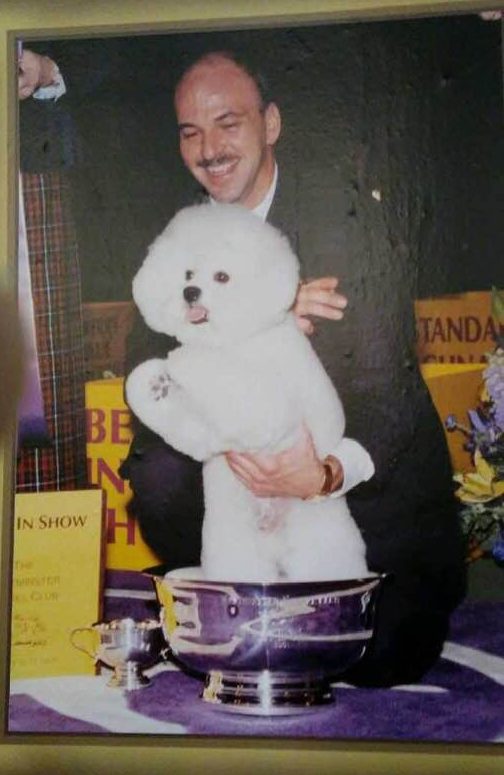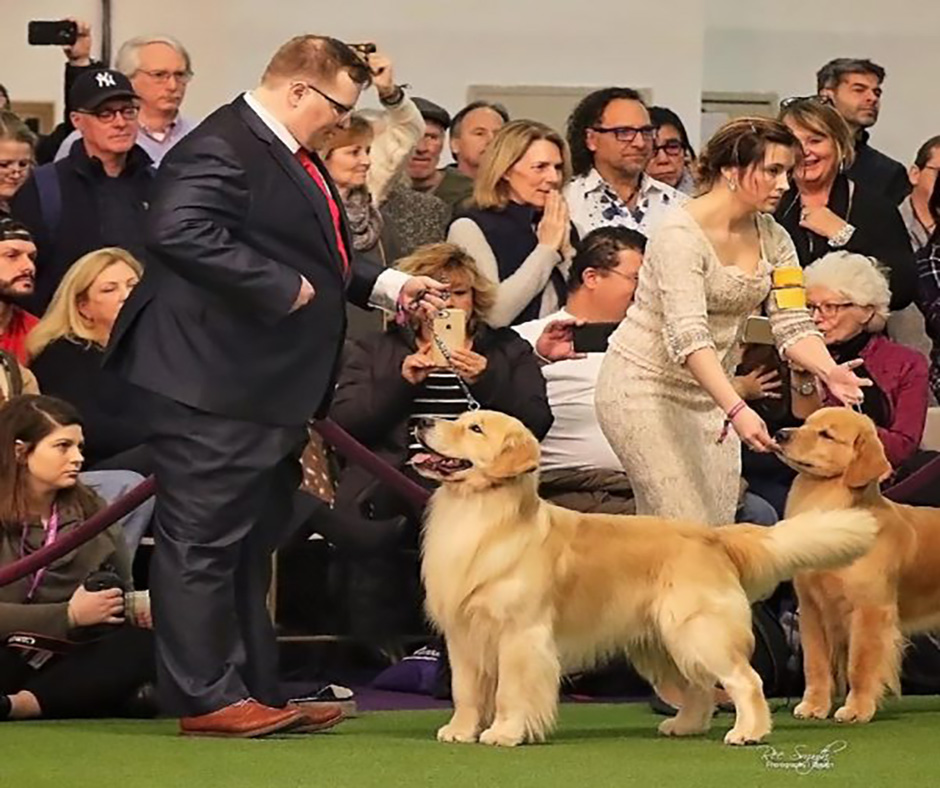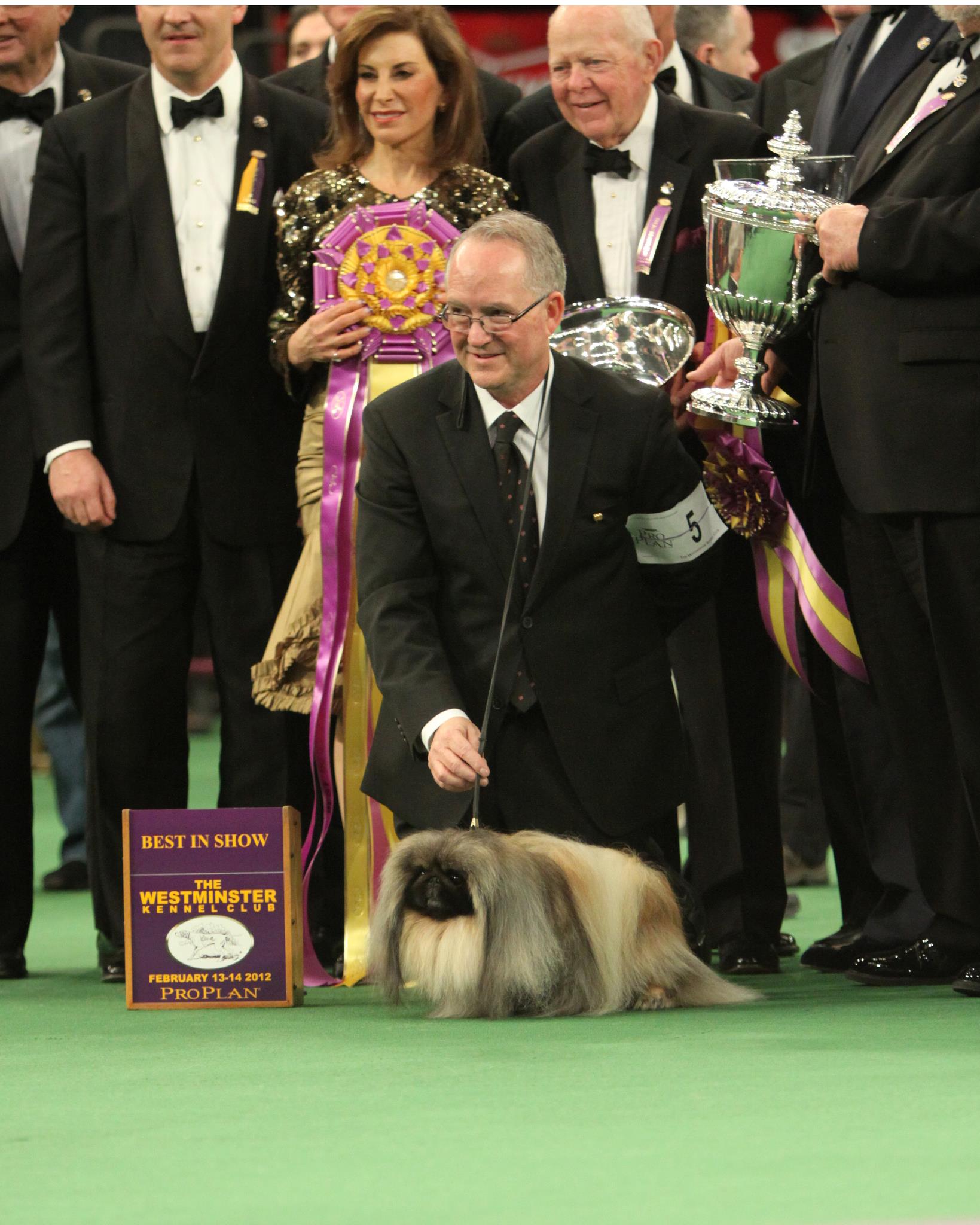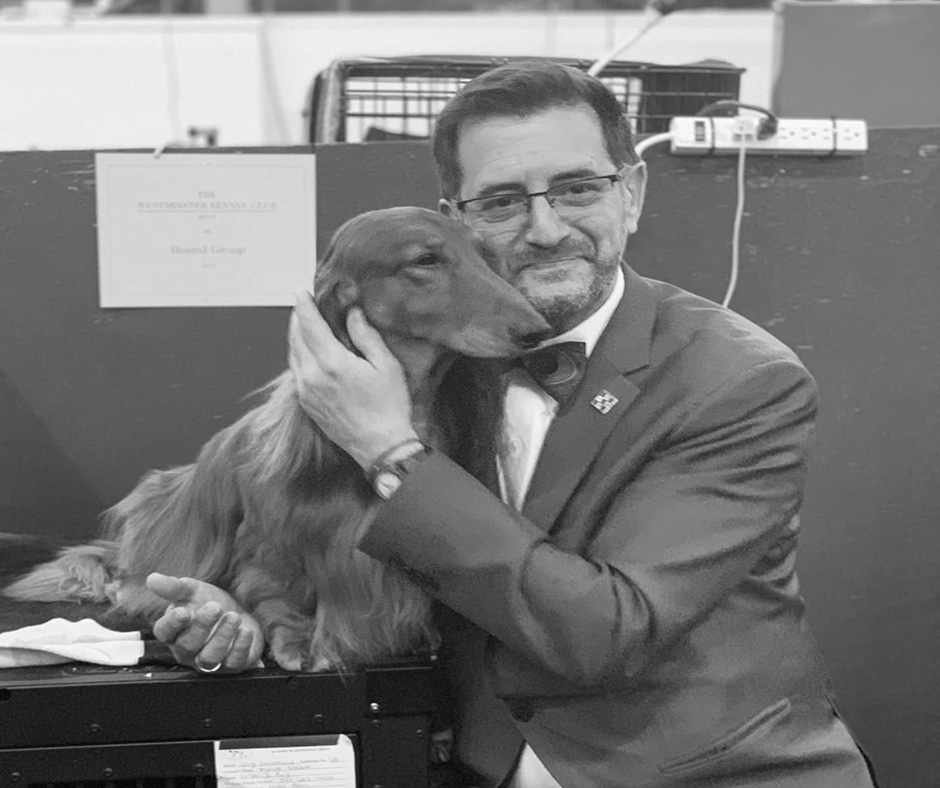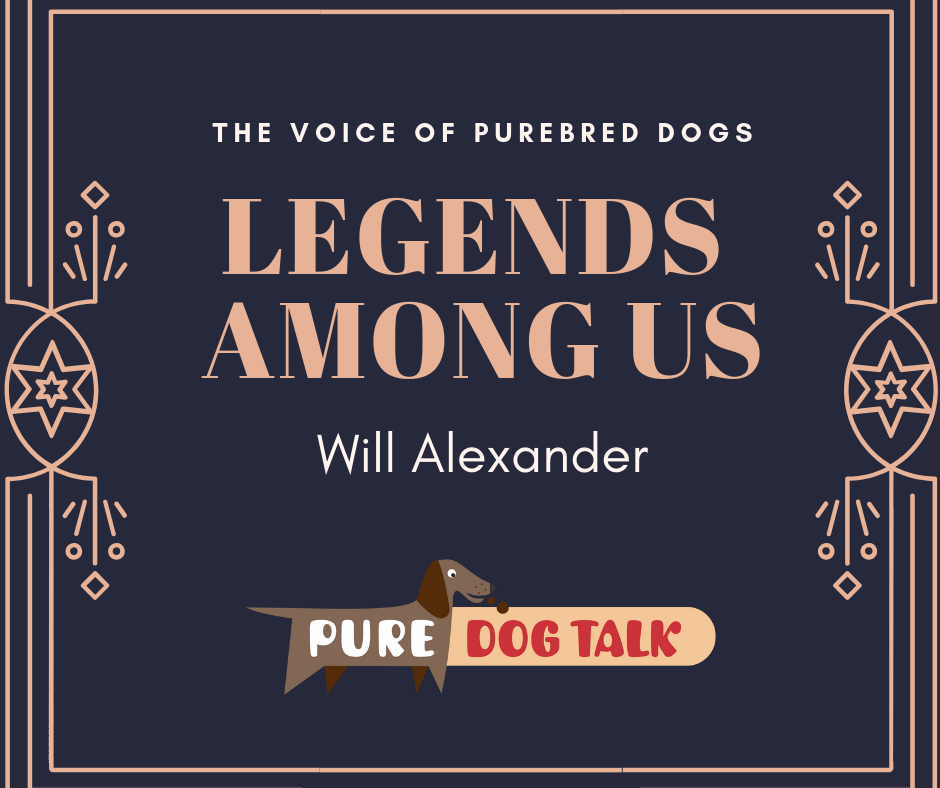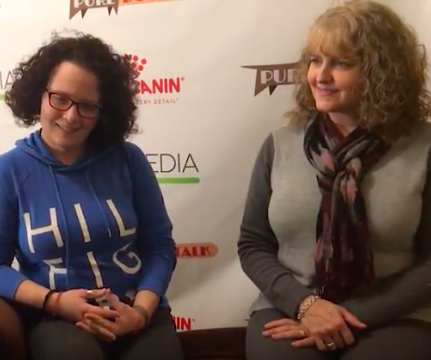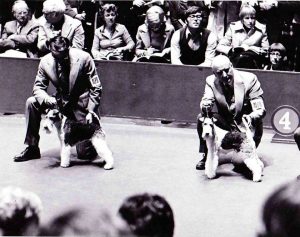353 – Scott Sommer 2: Money in Dog Shows and Setting Goals
Scott Sommer part 2: Money in Dog Shows and Setting Goals
Scott Sommer, one of only a handful of people to show multiple dogs to Best in Show at Westminster Kennel Club, joins host Laura Reeves in part two of this conversation for a deep dive on a tricky topic — money. How to get it, how to spend it and how much it matters.
Sommer also shares his view of the difference between a “good” dog and a “great” dog. For him, it’s all about the dog’s “heart.” He describes the iconic Bichon Frise, JR, Ch. Special Times Just Right, as having a “heart of a lion.”
“Sometimes the dog with heart will beat a dog that is *technically* better simply because it will always perform, no matter the conditions,” Sommer said.
The back story on how Sommer acquired JR for his client, Cecelia Ruggles, and worked with JR’s owners, Eleanor McDonald and Flavio Werneck, is absolutely a testament to the power of determination.
“Flavio wanted me to have the dog,” Sommer said. “I called Cel every day for a month. Finally, I told her, ‘I don’t care who shows that other dog, it will beat this other dog we have every time,’” Sommer recalls. Next thing he knew, he was meeting Eleanor at the Houston airport with JR in a Sherpa bag and “shouting with joy.”
Campaigning a show dog, at any level, requires a plan, Sommer said. Whether your goal is to achieve number one status in your breed or number one all-breeds in the country, the steps are the same.
Have a goal
Every dog is different. A dog with breed type, soundness and heart is that once in a lifetime goal for all of us. Learn to be critical of your dog and know its strengths and weaknesses. Plan accordingly.
Create and stick to a sensible plan for the dog’s career. Know your budget, know your time and know your limits.
Take a listen to our previous episode where we take a deeper dive into how to make these decisions.
352 – Scott Sommer: Work Hard and Never Stop Trying
Scott Sommer: Work Hard and Never Stop Trying
Scott Sommer, one of only a handful of people to show multiple dogs to Best in Show at Westminster Kennel Club, offers his best advice for success.
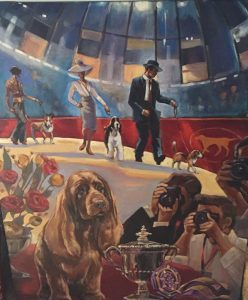 Both JR, the Bichon Frise and Stump, the Sussex Spaniel were surprise, dark horse winners at the Garden in their respective years. JR won under Dorothy MacDonald, defeating Mick, the incomparable Kerry Blue Terrier, handled by Bill McFadden, in a match up of Titans in the dog world. Stump was the oldest dog to win the coveted award. He came out of retirement to celebrate surviving a nearly tragic illness, winning under Sari Tietjen, the roar of the Madison Square Garden crowd ringing in Sommer’s ears.
Both JR, the Bichon Frise and Stump, the Sussex Spaniel were surprise, dark horse winners at the Garden in their respective years. JR won under Dorothy MacDonald, defeating Mick, the incomparable Kerry Blue Terrier, handled by Bill McFadden, in a match up of Titans in the dog world. Stump was the oldest dog to win the coveted award. He came out of retirement to celebrate surviving a nearly tragic illness, winning under Sari Tietjen, the roar of the Madison Square Garden crowd ringing in Sommer’s ears.
Sommer’s family bred smooth fox terriers. In fact, his mother sold legendary dog man Bobby Fisher his first show dog. Sommer showed his first dog at five years old and was hooked.
He later apprenticed for Bob and Jane Forsyth. On his 16th birthday, Sommer moved to Houston and went to work for Michael Kemp.
Best advice
His best advice? “Work hard and never stop trying. This is not something you can learn overnight. Work for it and you will get rewarded.”
“I think the initial steps are taking care of the dogs, cleaning them, feeding them, from there go forward,” Sommer said.
Top dogs
JR was the Number One ranked dog in country in 2001. But Sommer said he’d never shown the dog to MacDonald before that Best in Show lineup.
“How she decided between JR & Mick I’ll never know,” Sommer said. “I fully expected the Kerry to win. When she said ‘Bichon,’ I just ran…
“JR was a great show dog. He just never let down. It could be hot, cold, wet, it didn’t matter. He was so dependable. When you show a dog at that level that is so important,” Sommer added.
Both JR and Stump lived out their lives with Sommer. They were inseparable best friends and died a week apart.
Run!
Sommer’s best recommendations for the Garden include making sure large breed dogs have boots so the salt on the streets doesn’t hurt their feet.
“Go in with all the confidence in the world, hope and pray, and do the best job you can,” Sommer said. “If (the judge) points at you, RUN!
332 — Secret to Success with Owner-Handler Matt Palmer
The secret to Success with Owner-Handler Matt Palmer
The 2019 Secret to Success award goes to owner-handler Matt Palmer winning Best of Breed at Westminster Kennel Club with his first show dog. Host Laura Reeves gets up close and personal with everyone’s newest hero.
A Missouri State Public Defender, Palmer discovered Golden Retrievers at the Kennel Club of Philadelphia dog show he visited on a whim. He took AKC’s advice on how to find a reputable breeder, winding up with “great mentors, breeders who took a chance on selling a nice puppy to someone they didn’t know.”
“It’s remarkable the number of people who have “scaffolded me” in this sport,” Palmer said. “People have been amazing. Everyone I’ve come across has helped me in one way or another.”
Palmer said his secret to success came when he was working his dog at a handling class. An instructor noticed the dog tensing up when he was hand-stacked. After working through the problem, Palmer said he realized he “was worried about my jacket riding up and basically mooning everyone.” He bought a pair of suspenders on Amazon and his confidence skyrocketed. The team’s success took off from that point.
“I now own 10 pairs of suspenders and have a couple pair of extras in my tack box,” Palmer said.
“I wanted the purple and gold”
Palmer said his high school sports experiences left him “competitive to a fault,” and gave him the drive to achieve more. While he competed in the National Owner Handled Series his first year or so, glad to have extra time in the ring to practice, “I wanted purple and gold, not the maroon ribbon,” he opined.
Missouri to Manhattan
Deciding to attend Westminster Kennel Club was sort of a lark for Palmer. “I thought it would be cool to go see it. I had absolutely no expectation of significant success,” he said.
As his case load was starting to build up at work, Palmer had planned not to go. After visiting with professional handler friends at the dog show, he finally decided to go ahead and make the trip with them.
Professionals, not adversaries
“I think there is a divide between owner-handler and professional handler when there doesn’t need to be one,” Palmer noted. “I tell people I’m happy to help, hold dogs, etc if they could give me a few minutes of feedback.
“Any chance to learn from professionals is invaluable. I try to absorb things that are second nature, reflexive to them.
“My (professional handler) friend came early to meet me at the Piers so he could be ringside for the breed. He could have been in bed, but instead he grabs a bucket and a towel and stands ringside and cheers me on.”
Poop strike
The most terrifying moment of the Garden experience, Palmer said, is his dog wouldn’t potty. “He grew up in Kansas and Missouri, he’d never seen all that concrete. He wouldn’t poop! I was mortified he was going to touch that green carpet and decide it was a perfect place to poop,” Palmer said wryly.
“Dog shows have been a great social outlet,” Palmer said. “We’ll keep going. It’s so cool, everywhere you go, you see somebody you met somewhere else…
“Sometimes we win, most the time we don’t. But when we do, it’s pretty fun.”
For more inspiring stories of owner-handlers check out some of these past episodes:
57 – Best in Show: How an Owner-Handler Competes with the Pros – Tricia Stanczyk
318 – Owner Handler Secrets: Make a Plan and Be Consistent | Pure Dog Talk
25 – Patricia Trotter: Legendary Breeder, Author, and AKC Judge – Vin-Melca’s Norwegian Elkhounds
238 — The friendships and journeys of a successful owner-handler | Pure Dog Talk
270 – David Fitzpatrick on Pekingese, the Palace Dogs of Peking
David Fitzpatrick on Pekingese, the Palace Dogs of Peking
David Fitzpatrick, 2012 Westminster Kennel Club BIS winner with the Pekingese, Malachy, was obsessed with dogs as a child. Although his parents wouldn’t let him own a dog, he found ways to be involved with them by walking and housesitting dogs in the neighborhood.

David Fitzpatrick receiving the Westminster Kennel Club BIS ribbon from judge Cindy Vogels.
His passion took off around 1970 when he wrote a letter to a local handler to see if she needed help. Before he knew it, he was being picked up after school, earning $5/day helping her with Pekingese and other toy breeds.
“It could have been pretty much any breed,” Fitzpatrick said. “I fell into the lap of the Pekingese and loved them from the start. It was fate really.”
“Speak to anyone who is remotely involved with the Pekingese breed and the mention of David Fitzpatrick’s name will result in a degree of awe and reverence, for this American gentleman is acknowledged as being as fine a handler and presenter of a Pekingese as has ever been seen,” says noted British author Andrew Brace.
What is it about Pekingese?
The dogs of royalty in China, the first Pekingese specialty show was held in the US around 1908, Fitzpatrick said. “The breed attracted the pillars of society. They were the status symbol dog of the day and were the most popular toy breed into the ‘60s.”
“It is a detail oriented breed,” Fitzpatrick noted, “with their pear shaped body, rectangular head, features spread out and not crowded, heavy bone, crooked legs, level back and high tail set.”
Pekingese should have an intelligent expression, one that is almost arrogant and disdainful.
“Their true temperament is snooty,” Fitzpatrick said. “They were developed as palace dogs in China. They were royalty and had their own servants. They are generally waiting for you to do for them. It’s not a breed that really wants to please their humans.”
Pekes as pets
Fitzpatrick said the breed is great to live with. “They blend into the household,” he noted. “They get their loves and then go entertain themselves. They’re not constantly clawing at you like some dogs. They’re more independent.”
Pekingese have a great deal of personality, Fitzpatrick added. While they are at a show they are performing, showing their regal and aristocratic nature. At home, they’re like any other dogs, they chase squirrels and his dogs even dug out a nest of baby bunnies.
Breed specific presentation
“It’s up to us to show our dogs in a proper manner, not succumb to this crazy show biz of dogs chasing bait around the ring… an aristocratic breed really should not be begging for food, should they?”
266 – Westminster KC Treasure Trove: The VOICE of MSG and Yukon Vet
Westminster KC Treasure Trove: The VOICE of MSG and Yukon Vet
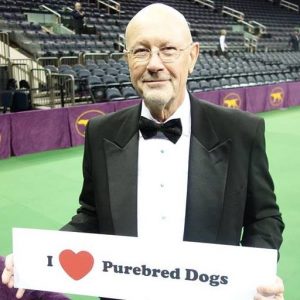
Michael LaFave, Westminster Kennel Club Announcer
“May we have the hound group please” may be the most thrilling line in dogdom. Westminster Kennel Club announcer Michael LaFave has been the announcer voice at Madison Square Garden for 18 years. Host Laura Reeves caught up with LaFave and Yukon Vet Dr. Michelle Oakley in New York City earlier this month.
LaFave was a Basset Hound fancier and president of Eastern Dog Club in Boston when the revered Roger Caras fell ill before the 2001 Westminster dog show. That last minute “fill in” assignment launched nearly two decades associated with his deep, powerful voice describing each dog being judged on the green carpet.
Intense moments and gorgeous dogs mark his tenure speaking to the thousands of fans filling the seats at the famed Manhattan venue. His favorite winner? Uno, the Beagle. His most memorable moment? The presentation to the Search and Rescue dogs who worked 9/11, just months after the tragedy.
Yukon Vet Debuts at Westminster

Nat Geo Wild series star Dr. Michelle Oakley, Yukon Vet.
Unlike LaFave, Oakley was brand new to Westminster Kennel Club. The TV star of the Nat Geo Wild reality series Yukon Vet was star struck herself as she met our famous canines. Fan girl moment? Biggie the pug. Oakley has a pug herself who she zips up in her snowmobile suit to take on two hour rides to her cabin.
She compared the agility competitors to sled dogs in their enthusiasm to work and reported “puppy breath wafting” from the floor of the show while watching the groups.
Her practical tips for living in sub-zero weather with dogs is to make sure they have boots, coats and possibly even an outdoor heat lamp for a place to potty when the weather is extreme.
Take a listen to her stories of weather change extremes in the Yukon, which disrupt and even kill hibernating animals.
Westminster was a “happy hunting ground” for podcast topics this year and we’re happy to share our discoveries with you.
264 — Carlos Puig: All About Dachshunds and Getting in a Dog’s Head
Carlos Puig: All About Dachshunds and Getting in a Dog’s Head
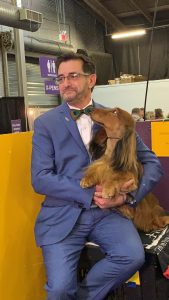
Handler Carlos Puig and Longhaired Dachshund, Burns, Hound group winner at the 2019 Westminster Kennel Club.
Anyone who watched the joy with which the Longhaired Dachshund, Burns, showed at Westminster Kennel Club last week, or loves Dachshunds in general, will appreciate this talk with handler Carlos Puig.
A Dachshund fancier, breeder and handler for 45 years, Puig brings out the pure spirit in each of his charges. How and why this “jazz pianist” of dog handlers does this is an amazing story. His encyclopedic knowledge of the Dachshund breed is equally impressive.
“(Dachshunds) are almost like an accordion,” Puig said. “They are very flexible because they had to be able to get in the badger den, maneuver underground and then back out.”
Dual Champion Does it All
In fact Burns, GCHP DC WALMAR-SOLO’S OMG SL JE, is believed to be the first dual champion of any breed to win a group at Westminster Kennel Club. Puig is proud that Burns has been successful in both field trials and earth dog events, proving that great show dogs can still do the work for which they were bred.
While Standard and Miniature Dachshunds have the same breed standard, Puig notes there are distinct differences between the varieties of coats and sizes. Smooths are the guard dogs, Longs are the snugglers and Wires will make you laugh, he said. And while Standards were bred for hunting badger, Minis are more about speed and were bred specifically for hunting rabbits and flushing deer.
“Back in the day (as the breed was developed in the 1800s) the best wires were standard longhairs bred to Dandie Dinmonts,” Puig said. “Which is why you still see lighter color hair on the heads of some Wire Dachshunds.”
Dog Handler as “Jazz Pianist”
Puig began his journey as a shy 11-year-old, house sitting for a neighbor who owned and showed Great Danes and later Dachshunds. He helped socialize puppies and groomed dogs for the owners while they were at shows because his parents were very protective and wouldn’t let him travel out of state.
“I learned to communicate with dogs before I learned to communicate with people,” Puig said. “I am grateful to the dogs…. they literally saved my life. I feed off the dog’s personality. You gotta get in their heads. I hate the robot dogs. There are never two dogs that are exactly alike. If you can’t pick up on that, you’ll get nowhere. I’m fortunate I started with Dachshunds, because I had to convince them they were doing what they wanted to do, not what I was making them do.”
262 — Will Alexander on Grooming, Handling and Heroes
Will Alexander on Grooming, Handling and Heroes
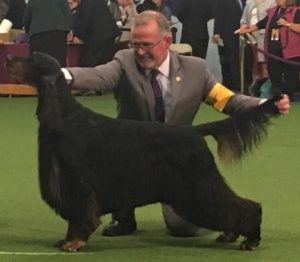
Will Alexander winning BOB in Gordon Setters at Westminster Kennel Club this week.
Canadian dog handling legend, Will Alexander, shares his memories, his handling tips and grooming tools that have brought him significant success in the last 25 years.
“My heroes were people like George Alston,” Alexander said. “He basically taught me to trim Irish Setters over the phone.”
“I always wanted to be a handler, but before embarking on a handling career I worked for Garry MacDonald in Canada, and for Bobby Stebbins in the States,” Alexander said.
Carving the picture
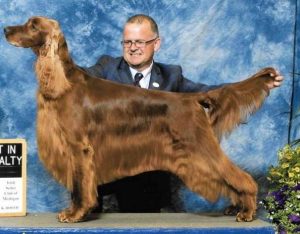
Will Alexander grew up with Irish Setters and learned from George Alston, over the phone, how to trim them.
Grooming is not a recipe, Alexander noted. Every dog is different. Famous for his meticulous grooming of setters particularly, Alexander describes a process to “build a shell around the dog” when trimming the back coat. He works with a stripping knife, his fingers, a grooming stone and, the most important piece, a bristle brush to bring up the oils in the coat.
Attention to detail
“I hate it when I hear “Oh, they won because they are so and so… well, they didn’t just grow up and they were so and so… they had to work hard to become so and so,” Alexander said. “It’s hard work. For every 15 minutes of fame there are 23 hrs 45 minutes working on your dog. It’s not age, it’s mileage.”
Tips of the trade
- Think in slow motion. In real time you’re doing exactly the right speed.
“When Miss P won the group at the Garden, George Alston called and yelled at me that I had gone too fast on the down and back. It was terrifying!”
- Attention to detail.
“I like to sit and watch the ring, pretend I’m in there already, making my mistakes in my head so I don’t make them in the ring.”
- “Old fashioned” isn’t bad
“I have a mind’s eye picture of the dogs. So much of type is in how they move, how they carry themselves,” Alexander said. “We need to be preserving the breeds not ‘improving’ them.”
Dream Best in Show Lineup
- English Springer Spaniel Ch. Salilyn’s Condor
- Borzoi Ch. Kishniga’s Desert Song
- Doberman Pinscher Ch. Brunswig’s Cryptonite
- Wire Fox Terrer ch galsul excellence
- Pekingese Ch. Wendessa Crown Prince
- Standard Poodle Ch. Rimskittle Ruffian
- German Shepherd Dog Ch Altana’s Mystique
BIS to Robert the Springer
For more information, videos, the book and more, visit http://www.doghandlingtips.com/
Allison & Laura Handicap the Line Up at Westminster Kennel Club
Special: Allison & Laura Handicap the Line Up at Westminster Kennel Club
Special edition!! Allison & Laura jam on the Westminster Kennel Club show, the fabulous contenders and who may or may not rise to the top of the pack. Las Vegas oddsmakers have occasionally offered up a “line” on the Garden. But those are not Dog Show Divas! Pure Dog Talk brings you two of the sport’s long-time observers with input on who stands a good chance in the green carpet final seven line up this year.
Whiskey the Whippet and King the Wire Fox Terrier are high on the list of the potential winners. The Havanese, Bono, is peaking at the right time but could be pushed by Treasure, the Papillion. The Border Collie, Slick and the new German Shepherd Dog, Tony, are set to duke it out in the herding group. A surprise appearance from Elsa the Old English Sheepdog could upset that applecart.
Breed judging on Tuesday will make or break a lot of the group judging. Will Bean the Sussex Spaniel who won the group last year come back and play in BIS again? Or will the brand new English Setter, Penny, come on strong? Sporting is in play!
Working group is being judged by Jimmy Moses. Questions about what Doberman will get to the group and what Boxer will win the breed have a lot to do with which dog could win the group. Once again, up in the air. Allison says, “Jimmy Moses will pick a solid dog, but what’s he gonna get to work with?”
Jim Reynolds to Christine Erickson to Peter Green. Is this the fairy tale line up for King and Gabriel?
Allison is going all Ws…. She’s putting her line up as BIS to the Wire Fox Terrier and RBIS to the Whippet. Laura has her heart and her money, long odds, on the Wire Fox Terrier and the Havanese as RBIS.
Check out the Dog Show Divas with the best line on the best in show line up at Westminster Kennel Club on Pure Dog Talk! Vegas got nothin’ on us, baby!
238 — The friendships and journeys of a successful owner-handler
Sealyham Terrier owner-handler at the 2018 Westminster Kennel Club
Olga Forlicz and Leslie Jaseph, Sealyham Terriers breeders, share stories about the international friendships and journeys of a successful breeder owner-handler.
Details matter
Jaseph shares her experience showing in the hyper competitive East Coast terrier groups, many of which are dominated by top professional handlers.
“You have to go in the ring with your dog trained and prepared like any other person in the ring,” Jaseph said. “You have to understand preparation and trimming. You can’t make an excuse. You and your dog have to be prepared.”
No excuses
Jaseph’s highly successful bitch was entered at Westminster Kennel Club, but she didn’t bring her because she wasn’t quite back to top condition from her litter of puppies.
“You have to have high standards,” Jaseph said. “Never bring your dog out unless you feel it can win.”
US versus Europe
Forlicz, who lives in Poland and is the breeder of Jaseph’s competitive bitch, compared European and American shows. She said that the general level of grooming and overall presentation is much higher here in the US.
“In Europe we have famous breeders, but not as many professional handlers,” Forlicz said. “It is maybe easier for the average person to compete at a high level.”
Forlicz added that while there are more shows in the US, Entries are typically much larger in Europe.
International partnership
Jaseph approached Forlicz to purchase a dog because she was “looking for something tightly bred, that phenotypically was a good match for anything in the US.”
Breeders should “Get out your ruler and measure the dog,” Jaseph said. “Compare it to standard, break it down.” She also noted that within style variations, balance is the key in the breed.
Her general assessment of the breed, although it is numerically threatened worldwide, is that overall coats and movement are good. Her observation is that breeders should pay attention to tailsets and the length and strength of heads.
The full-length video interview also is available at the Pure Dog Talk YouTube channel, here: https://www.youtube.com/watch?v=6qr5CEfpFIk
218 – Legendary Dog Man Peter Green Brings History to Life
Peter Green riffs on great dogs, great rivalries and great memories
Join a wonderful conversation between legendary dog man Peter Green and his former apprentice Robert Paust, now an AKC judge in his own right. The two old friends reminisce about great dogs of the past, great wins, great friendships and great rivalries.
Green’s Welshman brogue has blurred but not faded from his voice in the 50-plus years he’s been working with dogs in the U.S. Starting in dogs showing Welsh Terriers with his uncle, Green began his career in the States in 1963. As was common at the time, he worked as a private handler for a prominent kennel to learn the business.
WKC BIS with the Lakeland
His professional handling career kicked in to high gear after he won Best in Show at Westminster Kennel Club with the great Lakeland Terrier, Ch. Stingray of Derryabah, in 1968. In a career that spanned 40 years as one of the pre-eminent professional handlers in the country, Green piloted dogs to the big ribbon at the Garden four times. He is slated to judge BIS on the green carpet this coming February.
Green was very definite on his favorite dog of all time. In all the dogs, in all the years, the Wire Fox Terrier, Ch. Sunnybrook Spot On was his choice without hesitation.
Spot On vs Dominator and other great battles
Peter Green, left, with Spot on and George Ward, right, with Dominator in one of the most-watched rivalries of the era.
Listening to Green flashback to the tremendous competition with his friend and rival George Ward, showing Spot On’s son, Ch Aryee’s Dominator, is a rush. Even as he’s reminiscing, Green is teaching without even thinking about it. He talks about how he showcased his dog’s movement in this high-stakes competition.
Dog show drama was alive and well, even in the “good old days,” according to Green. Good natured rivalries, and even those that weren’t so pleasant, behind the scenes stories, flaring tempers and redemption all flow from his memories.
Enjoy this priceless window into history.


